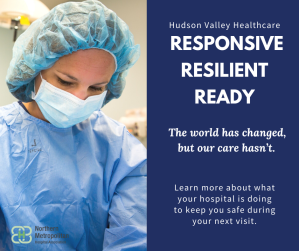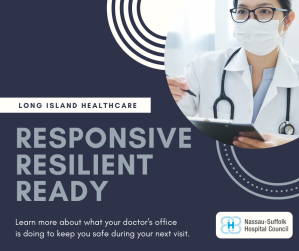Guest blog from the Dahill Dose.
Campaign draws attention to safety, infection control protocols
Delaying care can lead to more acute and complicated health problems
We have come a long way since New York recorded its first coronavirus patient on March 1, 2020. Thankfully, today, the number of daily coronavirus cases has decreased dramatically.
Now, fears about utilizing hospitals and physician offices for routine, but necessary care could spark another crisis of sorts. Routine care, screenings, and vaccinations serve to blunt more complex health issues if left unattended. Delaying care is not the healthiest option. All hospitals in the suburban regions were recently given the green light to resume elective surgeries and scheduling a procedure sooner rather than later is a wise decision.


It is understandable that patients are wary of accessing care, and they fear for their safety in such settings. But throughout this pandemic, hospitals took extraordinary measures with infection control and safety protocols to protect patients and staff. This continues full force. Social distancing in waiting areas, temperature checks, and deep sanitization, are some of the measures your healthcare providers are taking to keep you safe during your next visit.
Recent studies and polls show that many consumers are delaying care – some with telltale signs of heart attack or stroke are not going to the emergency department where immediate care and minutes are critical to a positive outcome. One study shows ischemic stroke patients are arriving at the ER 160 minutes later as compared to a similar timeframe in 2019.
A poll conducted in late April by the American College of Emergency Physicians and Morning Consult found that nearly a third of American adults (29 percent) delayed or avoided care due to fears about contracting the coronavirus. A Kaiser Health poll conducted several weeks later found that nearly half of the adults surveyed said they or a family member skipped or delayed care due to the coronavirus. But most said they expect to access care within three months.
Responsive, Resilient, Ready – this is the message healthcare providers throughout the Hudson Valley and Long Island regions have for patients. The world has changed, but their care has not. Consumers can read about the specific steps that hospitals in their area are taking to keep patients safe during their next in-person visit by visiting the Responsive, Resilient, Ready page maintained by the Suburban Hospital Alliance.
Consumers should also keep in mind that a region’s ability to remain open hinges on a few metrics maintained by hospitals. Ensuring that timely primary care and other care needs are handled in the community ensures that hospital capacity is not overtaxed with critically patients. As part of the governor’s New York Forward Plan, hospitals must maintain a 30 percent hospital bed and ICU bed capacity at all times.
About the Suburban Hospital Alliance of New York State
The Suburban Hospital Alliance of New York State advocates on behalf of hospitals in the Hudson Valley and Long Island regions. We engage key lawmakers and regulatory decision makers in Albany and Washington to ensure reasonable and rational health care policy prevails.
About the Nassau-Suffolk Hospital Council (NSHC)
The Nassau-Suffolk Hospital Council represents the not-for-profit and public hospitals on Long Island. It works in conjunction with the Suburban Hospital Alliance of New York State to advance legislative and regulatory priorities. NSHC serves as the local and collective voice of hospitals on Long Island.
About the Northern Metropolitan Hospital Association (NorMet)
The Northern Metropolitan Hospital Association represents the not-for-profit and public hospitals in the Hudson Valley region. It works in conjunction with the Suburban Hospital Alliance of New York State to advance legislative and regulatory priorities. NorMet serves as the local and collective voice of hospitals in the Hudson Valley.